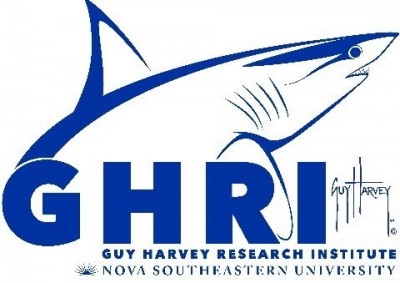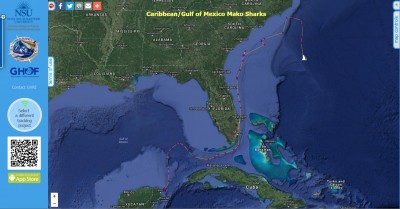NSU Newsroom
SharkBytes
Horizons
This version of NSU News has been archived as of February 28, 2019. To search through archived articles, visit nova.edu/search. To access the new version of NSU News, visit news.nova.edu.
This version of SharkBytes has been archived as of February 28, 2019. To search through archived articles, visit nova.edu/search. To access the new version of SharkBytes, visit sharkbytes.nova.edu.
Chasing the Fastest Shark in the World is No Easy Task
Guy Harvey Research Institute & Guy Harvey Ocean Foundation Satellite Tag 12 Mako Sharks During Recent Excursion
FOR IMMEDIATE RELEASE
FORT LAUDERDALE/DAVIE, Fla. – By all accounts, it was a very successful research trip.
When you’re studying the fastest sharks, there are a lot of variables that can come into play during a research trip. The weather may not cooperate, which can limit the time you have on the ocean to catch, tag and release the sharks. Then there’s the boat – like other forms of transportation, they are susceptible to breaking down and can have maintenance issues from time to time. And then, of course, you have the sharks, and they aren’t always that eager to cooperate – they simply don’t show up. As the old saying goes: That’s why they call it fishing and not catching.
Well, this year the stars aligned for a team of research scientists from Nova Southeastern University’s (NSU) Guy Harvey Research Institute (GHRI) and members of the Guy Harvey Ocean Foundation (GHOF) for their annual expedition to Isla Mujeres, Mexico to catch, tag and release shortfin mako sharks. Given speed of these sharks – they can swim in bursts up about 45 miles per hour – catching and tagging them can be quite the ordeal. That being said, the team successfully outfitted 12 mako sharks with satellite tags, making this the most successful expedition in the six year history of the program. And the clear waters provided the added advantage of allowing sharp video footage for studying the underwater feeding behavior of these incredible apex predators.
In the short time since the sharks were tagged on this recent trip, some have shown some amazing behavior. One shark, named Nolin, has decided to have his own “Tortuga Festival,” cruising around the Dry Tortugas while another shark, named Mackenzi, has decided to ditch the Gulf of Mexico and has headed nearly due north, skirting the coast of North Carolina, then headed a bit south and is now further east. Mackenzi is only the second mako of the 46 satellite tagged in the Gulf of Mexico that has veered off into the Atlantic, with all others staying in the Gulf of Mexico and Caribbean.
You can view these latest tagged mako sharks’ – and all the other tagged sharks – online in near real-time at nova.edu/sharktracking (choose the Caribbean/GOM project under the Mako Sharks heading.)
The sharks were tagged with Smart Position or Temperature (SPOT) tags that allow researchers to follow the animals in near-real time. Understanding the travel patterns of these sharks is a key component of helping ensure proper management of the species.
“The SPOT tags provide critical information about where these sharks travel and the habitat that they utilize,” says world renowned artist and conservationist Guy Harvey, who was on the expedition. “Understanding where these animals live is the first part to helping conserve this ecologically and economically important species.”
Mackenzi is a female shark that was tagged on April 16 and has logged nearly 1,800 miles so far. Nolin is a male shortfin mako shark, who has tallied more than 720 miles since being tagged April 17 (he’s decided to a little stick closer to home.)
The mako shark research program is part of ongoing research by GHRI scientists who are investigating the migration patterns of large pelagic fish, including shortfin mako, tiger and oceanic whitetip sharks and blue and white marlin.
Be sure to sign up for NSU’s RSS feed so you don’t miss any of our news releases, guest editorials and other announcements. Please sign up HERE.
###
About Nova Southeastern University (NSU): Located in beautiful Fort Lauderdale, Florida, Nova Southeastern University (NSU) is a dynamic research institution dedicated to providing high-quality educational programs at the undergraduate, graduate, and first-professional degree levels. A private, not-for-profit institution, NSU has campuses in Fort Lauderdale, Fort Myers, Jacksonville, Miami, Miramar, Orlando, Palm Beach, and Tampa, Florida, as well as San Juan, Puerto Rico, while maintaining a presence online globally. For more than 50 years, NSU has been awarding degrees in a wide range of fields, while fostering groundbreaking research and an impactful commitment to community. Classified as a research university with “high research activity” by the Carnegie Foundation for the Advancement of Teaching, NSU is 1 of only 50 universities nationwide to also be awarded Carnegie’s Community Engagement Classification, and is also the largest private, not-for-profit institution in the United States that meets the U.S. Department of Education’s criteria as a Hispanic-serving Institution. Please visit www.nova.edu for more information about NSU and realizingpotential.nova.edu for more information on the largest fundraising campaign in NSU history.
 About NSU’s Guy Harvey Research Institute: Established in 1999, the Guy Harvey Research Institute (GHRI) is a collaboration between the renowned marine artist, scientist and explorer, Dr. Guy Harvey, and Nova Southeastern University’s Oceanographic Center. The mission of the GHRI is to provide the scientific information necessary to understand, conserve, and effectively manage the world’s marine fishes and their ecosystems. The GHRI is one of only a handful of private organizations dedicated exclusively to the science-based conservation of marine fish populations and biodiversity. The research, education and outreach activities of the GHRI are supported by the Guy Harvey Ocean Foundation, AFTCO Inc., extramural research grants, philanthropic donations by private businesses and individuals, and NSU. Please visit nova.edu/ocean/ghri/index.html for more information.
About NSU’s Guy Harvey Research Institute: Established in 1999, the Guy Harvey Research Institute (GHRI) is a collaboration between the renowned marine artist, scientist and explorer, Dr. Guy Harvey, and Nova Southeastern University’s Oceanographic Center. The mission of the GHRI is to provide the scientific information necessary to understand, conserve, and effectively manage the world’s marine fishes and their ecosystems. The GHRI is one of only a handful of private organizations dedicated exclusively to the science-based conservation of marine fish populations and biodiversity. The research, education and outreach activities of the GHRI are supported by the Guy Harvey Ocean Foundation, AFTCO Inc., extramural research grants, philanthropic donations by private businesses and individuals, and NSU. Please visit nova.edu/ocean/ghri/index.html for more information.
June 1, 2017
Joe Donzelli | Office of Public Relations
954-262-2159 (office) | 954-661-4571 (cell)
jdonzelli@nova.edu | www.nova.edu
